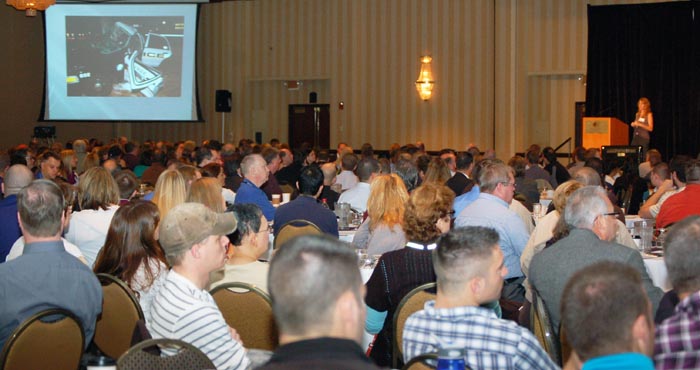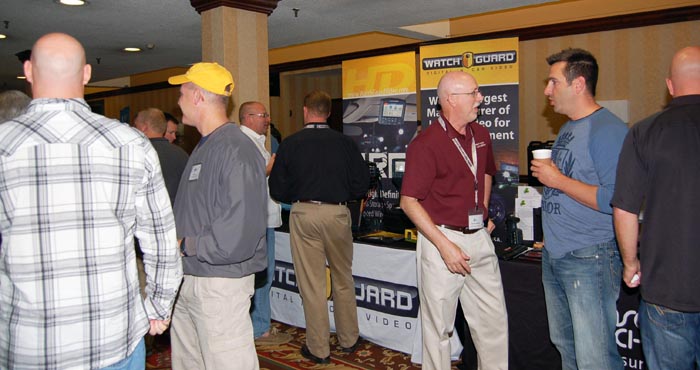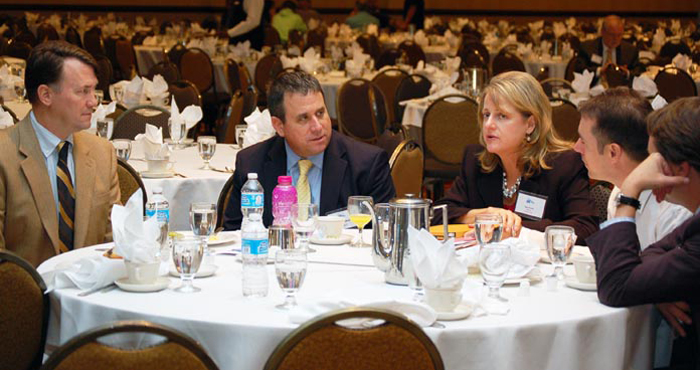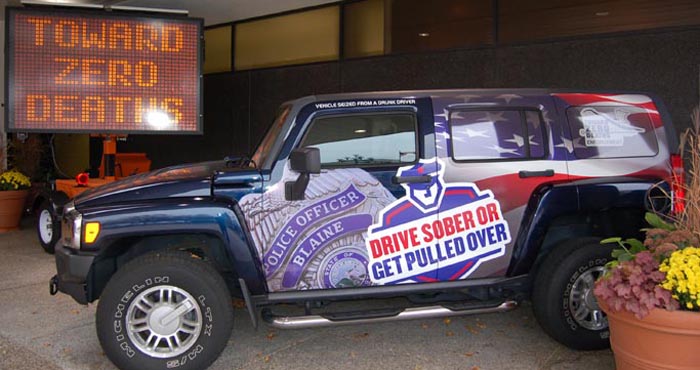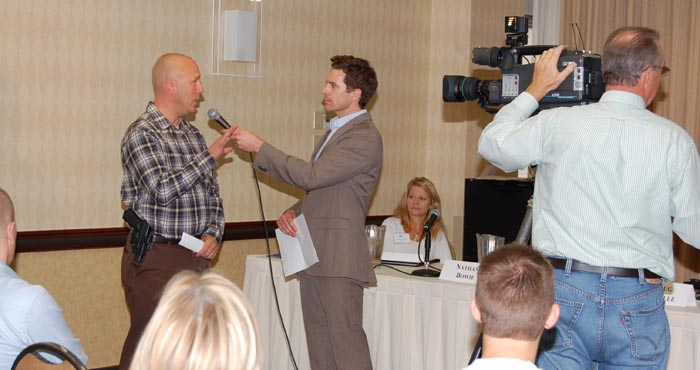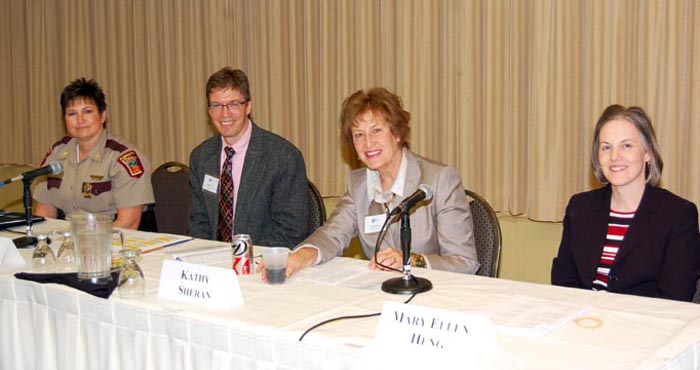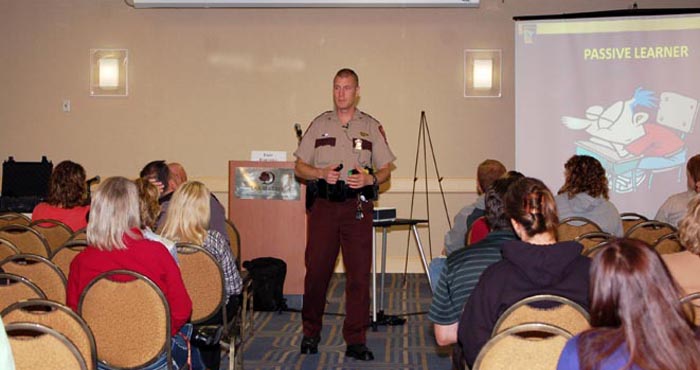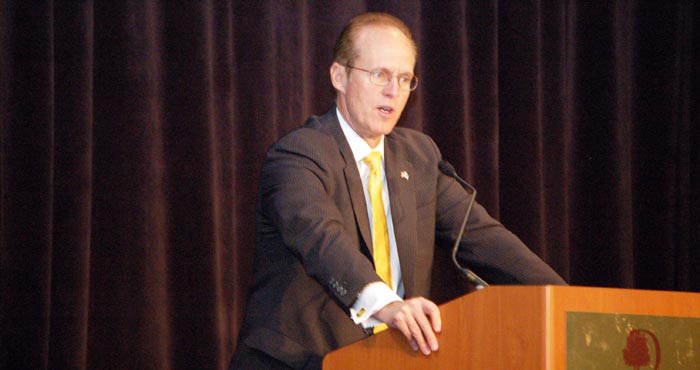- What is TZD?
- TZD Initiatives in MN
- Events
- News
- Resources
- Aggressive Driving
- Bicycling & Pedestrian Safety
- Child Passenger Safety
- Distracted Driving
- Education
- Emergency Medical & Trauma Services
- Enforcement
- Engineering
- Impaired Driving
- Intersection Safety
- Lane Departure
- Older Drivers
- Rail Crossing Safety
- Seat Belt Use
- Statistics
- Traffic Safety Legislation
- Videos
- Younger Drivers
2012 Toward Zero Deaths Conference
October 22-23, 2012
Bloomington, Minnesota
Conference Materials
- Final Program (185 KB PDF)
Conference Presentations
Presentations are posted for those sessions for which presenters granted permission.
Welcome and Opening Remarks
- Opening Remarks Presentation (756 KB PDF)
- "What's Your Goal?" video
Opening Plenary: Changing the Traffic Safety Culture in Agencies
This presentation highlighted ways to promote consistent traffic safety policies across agencies and organizations. As the chairman and CEO of the National Law Enforcement Officers Memorial Fund, Craig Floyd discussed his experience working with state agencies to promote this shift in culture.
Signs, Symptoms, and Behaviors of Drugged Drivers
Narcotic drugs and K2 synthetic cannabinoids can be very dangerous, especially when used while operating a motor vehicle. This session provided law enforcement officers, EMS personnel, and prosecutors information on the signs, symptoms, and dangerous behaviors of someone abusing these drugs. It also discussed how EMS and law enforcement can safely handle persons under the influence if they are encountered in traffic stops and/or crashes.
- Richard Moldenhauer, Alcohol and Drug Abuse Division, Minnesota Department of Human Services (2.17 MB PDF)
TZD Law Enforcement Grantees Meeting
This session reviewed the changes in the enforcement waves as well as the calendar for 2013. It included an overview of the e-grants reporting system and the new Real-Time Office Activity Reporting (ROAR). Participants asked questions and made suggestions to representatives of the Office of Traffic Safety.
- Lori Bounds, Shannon Swanson, and Jean Ryan, Office of Traffic Safety, Minnesota Department of Public Safety (2.13 MB PDF)
Minnesota’s Primary Seat Belt Law Saves Lives and Money
The University of Minnesota’s Center for Excellence in Rural Safety (CERS), on behalf of the Minnesota Department of Public Safety, conducted a study finding that Minnesota’s primary seat belt law resulted in 68 fewer deaths and 320 fewer severe injuries from 2009 to 2011. This session reviewed the study and its findings. It also discussed the state of the practice in evaluation processes and how the process utilized in this study could be applied to other projects.
- Frank Douma, Humphrey School of Public Affairs, University of Minnesota (811 KB PDF)
- Heather Darby, Office of Traffic Safety, Minnesota Department of Public Safety (798 KB PDF)
Saving the Lives of Our Lifesavers
Craig Floyd is Chairman and CEO of the National Law Enforcement Officers Memorial Fund, a nonprofit organization established in 1984 to honor the service and sacrifice of America’s law enforcement officers. Over the past 25 years, he has been one of law enforcement’s leading advocates—delivering speeches, hosting radio shows, publishing books, writing articles, and conducting media interviews. This presentation highlighted how he has worked to change America’s attitude toward the law enforcement profession and saving officers’ lives.
Safety in Work Zones – Using Automated Enforcement to Reduce Speeds
Work zones are a way of life for Minnesota motorists, but can be very dangerous for the workers improving our transportation system. This session discussed the technical details of automated speed enforcement systems that are being used in states outside of Minnesota to improve safety.
- Sgt. Mike Wallerstedt, Cedar Rapids Police Department (1.62 MB PDF)
- Priscilla Tobias, Illinois Department of Transportation, Bureau of Safety Engineering (2.24 MB PDF)
From Call to Transport: The Emergency Response System
When you dial 9-1-1, do you know where the call goes, how the decision is made on who responds, or how the response teams know where you are? Can you text 9-1-1 for help? This session not only covered new technologies that are being used within the 9-1-1 system, but also highlighted new innovations in sending crucial information from crash scenes to emergency departments prior to patient arrival.
- Ben Schooley, Center for Excellence in Rural Safety, University of Minnesota (853 KB PDF)
- Dana Wahlberg, Minnesota 911 Program, Minnesota Department of Public Safety (745 KB PDF)
- Brandon Abley, Emergency Communication Networks, Minnesota Department of Public Safety (6.31 MB PDF)
Statute and Case Law Review
This session provided a review of the DWI statute and case law as it relates to drug impaired driving.
- Karen Mara, City of Minneapolis (1.41 MB PDF)
TZD Safe Roads Grantees Meeting
To continue working toward its goal of zero traffic deaths and serious injuries on state and local roads, the Office of Traffic Safety (OTS) in the Minnesota Department of Public Safety is funding community coalition work through the TZD Safe Roads grant program. Three Safe Roads grant coordinators presented information on motivating active coalition members and working with the media to obtain coverage of traffic safety messages. OTS also led a discussion of requirements and the e-grant system. This session was designed for participants interested in forming a coalition in their community.
Automated Speed Enforcement – A Panel Discussion
Speed plays a significant role in several fatal and serious injury crashes in Minnesota. Automated speed enforcement systems can be an effective tool for managing speed and reducing speed-related crashes when used correctly and in the appropriate circumstances. In this session, we discussed potential automated speed enforcement legislation in Minnesota, the challenges in passing this type of legislation, and results of a public perception study on the technology.
Walk the Walk and Talk the Talk: Complete Streets for All
A safe street is a safe street for all users. This session examined strategies to identify non-motorist user needs, strategies to educate Minnesota’s future drivers through the Safe Routes to School program, and other traffic safety campaigns.
- Carla Stueve, SRF Consulting Group, and Jesse Reinhardt, Carver County (1.31 MB PDF)
- Fay Simer, Office of Transit, Minnesota Department of Transportation (2.44 KB PDF)
- Nick Mason, Bicycle Alliance of Minnesota (1.88 MB PDF)
Improving DWI Toxicology Testing
This session included discussion on drug toxicology of samples provided to the BCA lab for analysis in DWI cases. Current issues and challenges faced by BCA scientists in the lab and courtroom, updates on testing processes and equipment, and new testing equipment being acquired through the BCA to expedite and benefit the processing of toxicological samples were also presented.
- Donna Zittel, BCA Forensics Lab (4.12 MB PDF)
New DWI Tools—Ignition Interlock Circumvention and the Benefits of Mandatory E-Charging
This session explained what you need to look for and do when an interlock device is circumvented. There was also a panel discussion about the benefits of making e-charging mandatory in your agency.
- Jody Oscarson, Minnesota Department of Public Safety
- Ignition Interlock Circumvention presentation (2.48 MB PDF)
- Identification of Circumvention presentation (3.27 MB PDF)
- Jeffery Beahen, Rogers Police Department, and Dawn Speltz, Carson, Clelland, & Schreder (442 KB PDF)
“I’m a Good Driver, but my Parents…” A Teen Driver Panel Discussion
This panel consisted of teen drivers discussing how their parents have influenced their own driving behavior. Topics such as family rules, driving limitations, and childhood observations of parents’ driving behaviors were discussed. This session helped TZD partners better understand how important parent awareness and involvement is in developing safer teen drivers
Reading Outside the Lines: Roadside Hazards and the Barriers that Protect Us
Barriers and other safety hardware are continuously improved. This session highlighted alternative designs for roadside barriers and crash worthiness testing of roadside equipment.
- Mike Elle, Office of Project Management and Technical Support, Minnesota Department of Transportation (3.17 MB PDF)
- Hatem Qamhieh, Office of Project Management and Technical Support, Minnesota Department of Transportation (1.91 MB PDF)
- Michelle Moser, Office of Traffic, Safety, and Technology, Minnesota Department of Transportation (1.96 MB PDF)
Car Seats Do Work: A Regions Hospital Case Study
Doctors have told far too many parents their child will never be the same again following a traffic crash. In this presentation, hospital and pre-hospital medical providers shared a case study highlighting how proper child restraints help reduce the severity of injuries, as well as why and how children get injured in motor vehicles. The presenters discussed all aspects of the crash, from arrival on-scene through patient rehabilitation.
- Jessie Nelson, Regions Hospital (366 KB PDF)
Fiery Crashes
Every year victims in car crashes sustain serious burns or even die while trapped in their burning vehicles. This session reviewed several cases of burns sustained after a motor vehicle crash. Techniques were shared on how to protect yourself while safely extricating patients involved in car fires, and how to safely treat patients once extricated.
- Capt. Joe Schulz, Minneapolis Fire Department (90 KB PDF)
- Anne Lambert, Hennepin County Medical Center (526 KB PDF)
The Basics of Commerical Vehicle Enforcement: It’s Not Scary
Many law enforcement officers are leery of enforcing commercial vehicle laws if they are not an official commercial vehicle inspector. This session assisted officers in learning the basics of commercial vehicle enforcement.
Technology Keys and Tools in Traffic Safety
As smartphones become more common, there are a large number of application programs that can help make you more effective in your safety practice. Capturing data has never been easier and transmitting it electronically can improve efficiency, as well as provide documentation and records to make your practice more effective and efficient. Computers on our desk or in our hand allow us to be more efficient if we know how to use the technology. This session reviewed applications and online resources that are available and discussed how to create new apps to fit your needs.
- Laura Ooley, Appmosphere, Inc. (2.17 MB PDF)
The Sharpest Tools in the Shed: Engineering Tools for Safety-Minded Decision Making
Public perception of risk often deviates from true risk. This session provided an overview of tools used for objective assessments of traffic safety risks that will support safety-oriented engineering and planning decisions.
- Katie Fleming, Office of Traffic, Safety, and Technology, Minnesota Department of Transportation (3.09 MB PDF)
- Derek Leuer, Office of Traffic, Safety, and Technology, Minnesota Department of Transportation (1.14 MB PDF)
- Tim Neuman, CH2M Hill (2.61 MB PDF)
Saving Minnesota’s Youth
Traffic crashes are the top cause of death for Minnesota teens between the ages of 15 and 17. How can we stop these crashes and save teenage lives in our state? Education is a key component. This session took an in-depth look at traffic safety through the eyes of a teenager and explored several programs designed to engage teens and young drivers to be safer on our roads.
- Todd Emanuel, Mayo Clinic (1.21 MB PDF)
- Lisa Kons, Minnesota Safety Council (265 KB PDF)
- Gordy Pehrson, Office of Traffic Safety, Minnesota Department of Public Safety (374 KB PDF)
Bath Salts: What the Traffic Safety Community Needs to Know
This presentation included detailed information about synthetic cathinones (bath salts), including national trends, effects on the human body, and interesting case studies.
- Lt. Tom Reagan, Bangor, Maine Police Department (7.54 MB PDF)
Breathing Life into Your Presentations – Using Games to Teach Core Content
Are your trainees really paying attention? The answer to that question is critical to the success of any training session. This presentation explored the use of games to engage, motivate, and energize your trainees. It addressed how you can enhance your training through the use of a game, and showed how games can be an effective teaching tool to introduce or review any topic. Also covered were simple guidelines for game use and warnings of common pitfalls. Attendees learned how to create a compelling game from a traditional PowerPoint lecture format and discussed ways to make classrooms more interactive.
What Would You Do? An Ethical Conversation on Traffic Safety Topics
This session provided an interesting look at ethical issues surrounding the four Es. Do you wear your seatbelt when no one else is watching? Does “55” really mean “55”? This session took a deeper look at the ethical issues that the four Es are faced with every day.
We’re at a Crossroads: Conflict Management at Intersections and Interchanges
This session covered a few approaches used by engineers to reduce conflict at intersections and interchanges, as well as approaches to improve access.
- Tom Dumont, District 3, Minnesota Department of Transportation (5.14 MB PDF)
- Kristi Sebastian, Dakota County (2.16 MB PDF)
- Suzanne Hanrahan, Dakota County (402 KB PDF)
Trains, Trucks, Bikes, and Pedestrians: Multi-Modal Transportation Safety Programs to Keep on Rolling
This session examined methods used to promote safety and the TZD mission among special roadway users including bicyclists, pedestrians, commercial vehicles, and railroads.
- Simon Blenski, Minneapolis Public Works, and Steve Clark, Transit for Livable Communities (3.22 MKB PDF)
- Gary Johnson, Anderson Trucking Services, Inc. (392 KB PDF)
- Susan Hall, Office of Freight and Commercial Vehicle Operations, Minnesota Department of Transportation (1.64 MB PDF)
Meet the Manufacturers Featuring Chicco and Diono, LLC
Check out the latest and greatest from car seat manufacturers, Chicco and Diono, LLC. Representatives from Chicco and Diono, LLC presented changes and updates regarding their child safety seat line and answered questions from the audience.
- Julie Prom, Chicco (1.39 MB PDF)
- Allana Pinkerton, Diono, LLC (2.58 MB PDF)
Sponsors
The conference was offered by the Minnesota Toward Zero Deaths Program and the Minnesota Departments of Public Safety, Transportation, and Health.
Additional sponsorship was received from:
 |
 |
|
 |
 |
